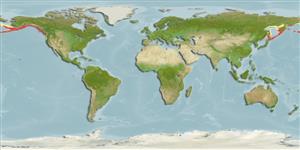>
Perciformes/Zoarcoidei (Eelpouts and pricklebacks) >
Ptilichthyidae (Quillfish)
Etymology: Ptilichthys: Greek, ptilon = feather + Greek, ichthys = fish (Ref. 45335); goodei: Named after Dr. G.B. Goode, U.S. ichthyologist (Ref. 6885).
More on author: Bean.
Environment: milieu / climate zone / depth range / distribution range
Ecologie
marien demersaal; diepte 0 - 360 m (Ref. 50550). Temperate; 66°N - 42°N
North Pacific: Japan, the Sea of Okhotsk, and the Kuril Islands to Bering Sea and to central Oregon, USA.
Grootte / Gewicht / Leeftijd
Maturity: Lm ? range ? - ? cm
Max length : 40.0 cm TL mannelijk / geslacht onbekend; (Ref. 56557); common length : 15.5 cm TL mannelijk / geslacht onbekend; (Ref. 56557)
Dorsale stekels (totaal): 90; Dorsale zachte stralen (totaal): 137-145; Anale stekels 0; Anale zachte stralen: 185 - 196; Wervels: 236 - 240. Caudal much reduced.
Found at surface at night, evidently on the bottom in deeper waters during the day (Ref. 2850). Buries itself in mud or sand (Ref. 2850). Has been recorded to be found in the stomach of a coho salmon (Ref. 6885).
Levenscyclus en paargedrag
Maturiteit | Voortplanting | Paaien | Eieren | Fecunditeit | Larven
Eschmeyer, W.N., E.S. Herald and H. Hammann, 1983. A field guide to Pacific coast fishes of North America. Boston (MA, USA): Houghton Mifflin Company. xii+336 p. (Ref. 2850)
Status op de Rode Lijst van het IUCN (Ref. 130435)
Gevaar voor de mens
Harmless
Gebruik door de mens
Meer informatie
Lokale namenSynoniemenMetabolismePredatorenEcotoxicologieVoortplantingMaturiteitPaaienPaaiaggregatiesFecunditeitEierenOntwikkeling van de eieren
Leeftijd/GrootteGroeiLengte-gewichtLengte-lengteLengtefrequentiesMorfometrieMorfologieLarvenLarvale populatiedynamiekRekruteringAbundantieBRUVS
ReferentiesAquacultuurAquacultuurprofielKweeklijnenGeneticaElectrophoresesErfelijkheidZiektesVerwerkingNutrientsMassaconversie
Tools
Speciale rapporten
Download XML
Internetbronnen
Estimates based on models
Preferred temperature (Ref.
123201): 0.9 - 8.3, mean 4.4 °C (based on 378 cells).
Fylogenetische diversiteitsindex (Ref.
82804): PD
50 = 1.5000 [Uniqueness, from 0.5 = low to 2.0 = high].
Bayesian length-weight: a=0.00102 (0.00046 - 0.00225), b=3.06 (2.88 - 3.24), in cm total length, based on all LWR estimates for this body shape (Ref.
93245).
Trofisch niveau (Ref.
69278): 3.4 ±0.5 se; based on size and trophs of closest relatives
Fishing Vulnerability (Ref.
59153): Low to moderate vulnerability (30 of 100).
